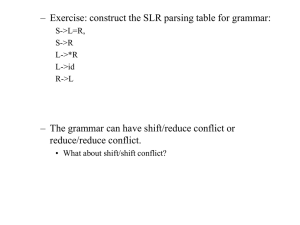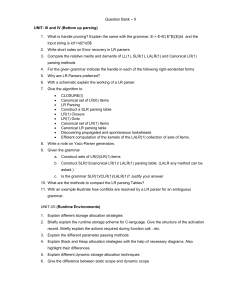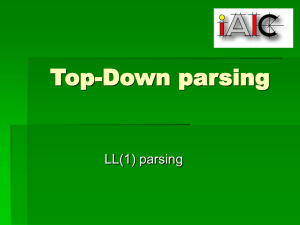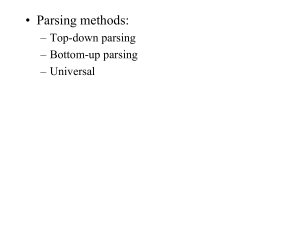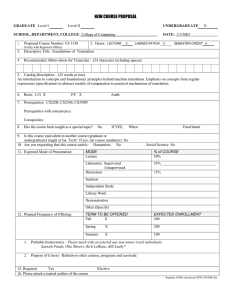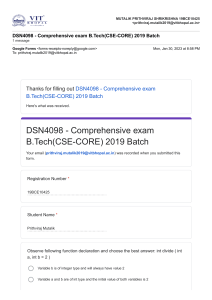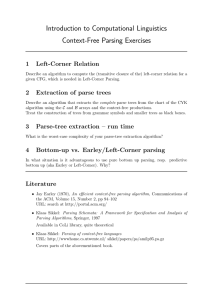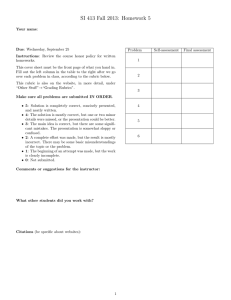Computing the First and Follow Functions
advertisement
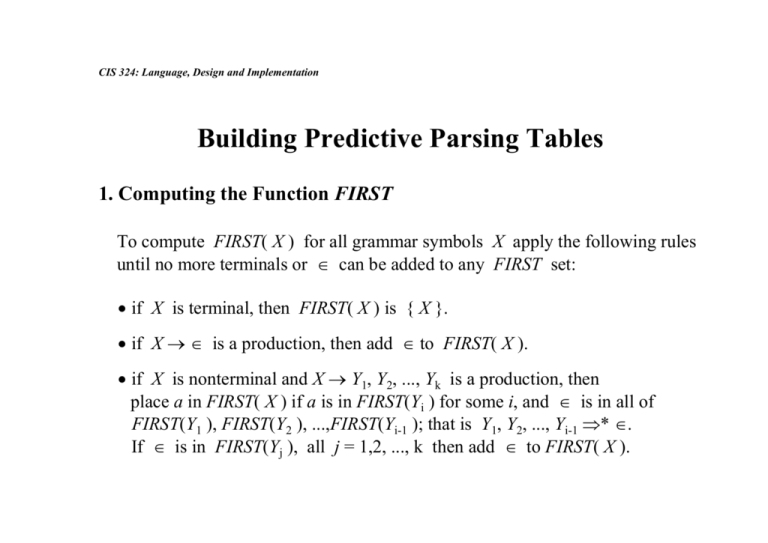
CIS 324: Language, Design and Implementation
Building Predictive Parsing Tables
1. Computing the Function FIRST
To compute FIRST( X ) for all grammar symbols X apply the following rules
until no more terminals or can be added to any FIRST set:
if X is terminal, then FIRST( X ) is { X }.
if X is a production, then add to FIRST( X ).
if X is nonterminal and X Y1, Y2, ..., Yk is a production, then
place a in FIRST( X ) if a is in FIRST(Yi ) for some i, and is in all of
FIRST(Y1 ), FIRST(Y2 ), ...,FIRST(Yi-1 ); that is Y1, Y2, ..., Yi-1 * .
If is in FIRST(Yj ), all j = 1,2, ..., k then add to FIRST( X ).
2. Computing the Function FOLLOW
To compute FOLLOW( A ) for all nonterminals A apply the following rules
until nothing can be added to any FOLLOW set:
place $ in FOLLOW( S ) where S is the start symbol and
$ is the input right marker;
if there is a production A B , then everything in FIRST( )
except the symbol is placed in FOLLOW( B );
if there is a production A B , or a rpoduction A B
where FIRST( ) contains , then everything in FOLLOW( A )
is also in FOLLOW( B ).
3. Construction of Predicting Parsing Tables
Algorithm for Construction of Predictive Parsing Tables
Repeat: for each production A of the grammar do
for each terminal a in FIRST( )
add A to M[ A, a ]
if FIRST( ) contains
add A to M[ A, b ] for each b in FOLLOW( A )
if is in FIRST( ) and $ is in FOLLOW( A )
add A to M[ A, $ ]
make each undefined entry of M be error
Example: Construct a predictive parsing table for the following grammar:
P bSe
S AR
R AR |
A id = E ;
E FT
T +FT |
F (E) | id | INT
The construction of the predictive parsing table begins with the
computation of the functions FIRST and FOLLOW:
FIRST( P ) = { b }
FIRST( S ) = { id }
FIRST( R ) = { id, }
FIRST( A ) = { id }
FIRST( E ) = { (, id, INT }
FIRST( T ) = { +, }
FIRST( F ) = { (, id, INT }
FOLLOW( P ) = { $ }
/ according to rule 1 /
FOLLOW( S ) = { e }
/ according to rule 2 /
FOLLOW( R ) = { e }
/ according to rule 3 /
FOLLOW( A ) = { id, } / according to rule 3 /
FOLLOW( E ) = { ; , ) } / according to rule 2 /
FOLLOW( T ) = { ; , ) } / according to rule 3 /
FOLLOW( F ) = { +, ; , ) } / according to rule 3 /
The parsing table for this grammar then becomes:
id
P
S
R
A
E
T
F
INT
=
+
;
S AR
R AR
A id = E ;
E FT
E FT
F INT
)
b
P bSe
e
R
E FT
T +FT
F id
(
T
T
F (E)
$
Using the above parsing table a simple string will be parsed as follows:
Stack
$P
$ eSb
$eS
$eRA
$eR;E=id
$eR;E=
$eR;E
$eR;TF
$eR;Tid
$eR;T
$eR;TF+
$eR;TF
$eR;TINT
$eR;T
$eR;
$eR
$e
$
Input
b id = id + 1 ; e $
b id = id + 1 ; e $
id = id + 1 ; e $
id = id + 1 ; e $
id = id + 1 ; e $
= id + 1 ; e $
id + 1 ; e $
id + 1 ; e $
id + 1 ; e $
+1;e$
+1;e$
1;e$
1;e$
;e$
;e$
e$
e$
$
Output
P bSe
S AR
A id = E ;
E FT
F id
T +FT
F INT
T
R

